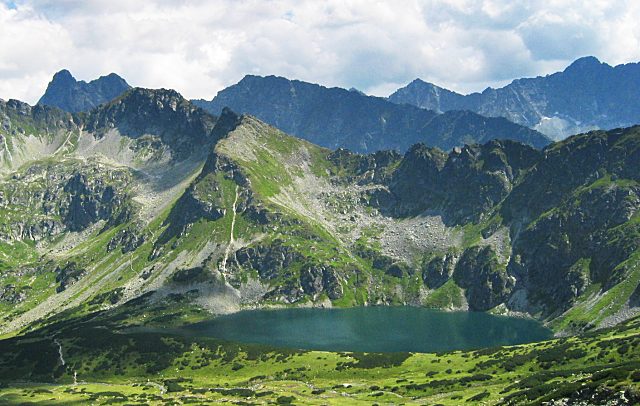- Tatra National Park, Poland
Infobox_protected_area | name = Tatra National Park
native_name=Tatrzański Park Narodowy
iucn_category = II

caption = Czarny Staw, a mountain lake near MtRysy
locator_x =
locator_y =
location =Tatra Mountains , southernPoland
nearest_city =
lat_degrees = 49
lat_minutes = 10
lat_seconds = 00
lat_direction = N
long_degrees = 19
long_minutes = 55
long_seconds = 00
long_direction = E
area = 211.64 km² (81.71 mi²)
established = 1954
visitation_num =
visitation_year =
governing_body = Ministry of the EnvironmentTatra National Park ( _pl. Tatrzański Park Narodowy; abbr. TPN) is a National Park located in the Tatra mountains in
Lesser Poland Voivodeship in southernPoland , borderingSlovakia . It was created in 1954 on an area of 215.56 km², but it is currently slightly smaller, at convert|211.64|km2|sqmi|abbr=on. Of this, 151.91 km² is forest and the remainder mainly meadows. Strictly protected zones account for 115.14 km², of which 61.49 km² are forestecosystems .The Park has its headquarters in the town of
Zakopane . There is also a similar national park on the Slovakian side of the border, called "Tatranský národný park".The first calls for protection of the
Tatras came at the end of the 19th century. In 1925 the first efforts to create anational park , in cooperation with Slovakia, took place. Formally the park was created in 1937, on an area that belonged to the state forests authority. In 1947, a separate administrative unit, Tatra Park, was created. And in 1954, by decision of the Polish Government, Tatra National Park was created. In 1992, the Polish and Slovakian national parks in the Tatras were jointly designated a transboundarybiosphere reserve byUNESCO under its Man and the Biosphere programme.Geography
The National Park covers the only
Alpine mountain range in Poland. The highest peak in Poland,Rysy (2,499 mAMSL ), is located here. The Polish Tatra range, which is a part of theCarpathian Mountains , is divided into two parts:High Tatras ("Tatry Wysokie") andWestern Tatras ("Tatry Zachodnie"). The landscape consists of sharp-edged peaks and hollows with numerous rock formations. There are around 650 caves, of which the cave systemWielka Sniezna is the longest (18 km) and the deepest (maximum depth 814 m). Six caves of the system are open to public.Geology
There are several streams and around 30 mountain lakes called "staw" (pond). These water bodies are an important part of the High Tatra landscape. The largest lakes are:
Morskie Oko with an area of 349,000 m² and maximum depth of 50.8 m, andWielki Staw Polski with an area of 344,000 m² and maximum depth of 79.3 m. Longest streams reach 20 km. Waterfalls, such asWodogrzmoty Mickiewicza are popular with tourists. The highest waterfall isWielka Siklawa at 70 m.Biology and ecology
Flora
Up to 1,250 m there are mainly
fir andbeech forests. Higher levels, up to 1,550 m, are covered withspruce forests, which turn into grassland at higher heights, which grows up to 1,800 m. The highest level, above 1,800 m, is of Alpine character.Fauna
The National Park contains several endemic species and many endangered and protected ones. Animals include:
Tatra chamois andmarmot , both protected since the mid-19th century,brown bear ,Eurasian lynx ,wolf ,otter ,eagle , andfalcon .Human life
The park is home to original culture and folklore preserved by the Polish highlanders ("
górale "). The most precious elements of their culture are language, clothes and customs. Their past is preserved in oral stories and traditional architecture, such as huts.Environment and tourism
The area of the Tatra mountains was exploited by human activities in the past. During summer numerous herds of animals (like goats, sheep and cows) pastured on the meadows and these practices caused erosion processes. In the 18th and 19th centuries several mines and
ironworks were built here, and these establishments needed a lot of timber. Tourism has developed since the late 19th century, and the excessive number of tourists is the largest threat to Park’s nature now. Other threats are proximity of the fast-developing town ofZakopane ,air pollution from the industrial zones inKraków ,Ostrava and Orava, andpoachers .Tatra National Park covers only 0.07% of Poland, but it is visited by more than 3 million tourists every year,Fact|date=June 2007 which makes it the most visited national park in Poland. The current infrastructure, such as hotels and car parks, is not sufficient for the current amount of visitors.Fact|date=June 2007 Some time ago fees for entering the park were introduced.Fact|date=June 2007
External links and references
* [http://www.tpn.pl/ Official website] pl icon
Wikimedia Foundation. 2010.
